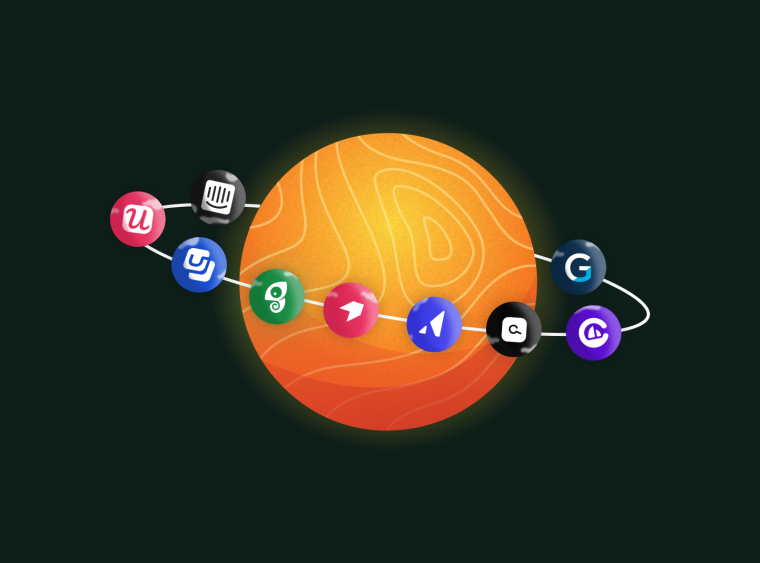First impressions are the most lasting. That’s why buying experience is considered one of the most important things in modern sales that defines the prospect's attitude toward your business in the future.
Offering a positive experience will make your customers stay with you longer, return in the future, and recommend you to their network. This means you should be as attentive to your prospects as possible at every stage of their journey, be it awareness building, discovery, negotiations, onboarding, or even when they decide to churn.
How do you do that? Read on to find out.
The impact of positive buying experience
Let’s start with the basics. The buying experience is how your prospective customer perceives the whole process of making a purchase, from being completely unaware of your product to becoming your customer.
A positive buying experience has a lot to do with emotions. Be it an initial contact, negotiations, or objections handling, the way you interact with your prospects, and the way you make them feel in the process will greatly affect the outcomes of their buying journey.
How is this different from the customer experience? As the name implies, the buying experience is typically focused on prospective customers rather than existing ones. This is why it tends to get less attention than other aspects of the customer journey, according to CustomerThink.

(Source)
And that is a big mistake. After all, if a prospect gets a poor buying experience, the chances that they will actually become a customer are pretty low, regardless of how amazing your post-purchase customer experience is.
That said, a positive buying experience offers a ton of benefits:
Increased conversion rates
Higher average deal size
Shorter sales cycle
Lower customer churn
More referrals from customers and prospects
How to delight your prospects
To provide a stellar experience means to meet and exceed the potential buyer’s expectations. Easier said than done, huh?
Ideally, you should start with understanding two things: what your competitors do (so you can try and do it better) and what kind of experience your buyers expect (to know what you should improve).
Based on that information, you can try and adjust the experience to make sure it is:
Relevant: You’re targeting the right people with the right messaging at the right time using the right channels and tools
Effortless: The prospects don’t have to go through a lot of hoops to get what they need
Transparent: The prospects understand what you’re doing (or expect them to do) and why
However, you should know that there are aspects of buying experience that isn’t exactly in your hands.
The aspect of buying experience you can’t control
Before we talk about the essential yet often disregarded aspects of a positive experience, it’s worth mentioning one thing you can’t really control, no matter how hard you try. It’s how your prospective buyers discover your product and at which point they decide to reach out to you after they discover your product.
Namely, the recent study by Gartner finds that sales reps have only about 5% of a customer’s time during their buying journey. Most buyers prefer to do some research on their own before reaching out to you. That is especially true for B2B and SaaS buying cycles.
Sure, the whole point of product marketing is to make sure the prospects learn about your product and develop the need to buy it. It's a sweet spot between your sales, marketing, and product development efforts.

However, it’s impossible to be 100% sure that your message has actually reached the right person at the right time. One way to get control over how prospects learn about you is to proactively engage them using outbound strategies. Whether it’s a targeted advertising campaign or cold outreach, this gives you an opportunity to build awareness or kick off the buying journey.
However, there’s always a chance that this won’t be the first time they hear about your product. This means you shouldn’t focus solely on outbound or inbound tactics. It’s best to use a combination of the two. Just make sure the experience you offer is consistent across all the campaigns, channels, touchpoints, messaging, etc.
5 overlooked aspects of a B2B buying experience
The good news is that there are a lot of things in creating a positive buying experience that a business can influence and, as a result, improve. Sadly, some of them often escape the attention of product owners and managers. Let’s take a look at the most frequently neglected aspects, and how to make sure you pay attention to them.
1. Discovery
As buying journeys become more complex (some taking over a year to complete), you might get tempted to speed things up. This often means jumping straight to the demo and pitch as soon as they get a hold of the prospect.
Whether intentionally or not, many salespeople neglect the importance of proper discovery in the sales process. As a result, they miss a chance to figure out what the buyer is looking for, and their specific requirements, limitations, and preferences.
Being unaware of (or simply ignoring) the prospect’s needs, salespeople will force canned scripts and value props on the prospects. Needless to say, this can completely ruin their buying experience as well as damage your business reputation in general.
To avoid that, take some time to dive a little deeper into the prospect’s needs and goals to be able to tailor your further steps accordingly for the best outcomes. This is also a great opportunity to become a trusted advisor and build lasting relationships with your prospects, which is especially important for B2B SaaS businesses.
2. Omnichannel engagement
Too many companies focus on a single channel for prospect communication which isn’t just inconvenient, but can also seriously reduce your chances of success. Although 83% of consumers are willing to move between the channels when interacting with a brand, only 50% of companies support cross-channel communication.
On the other hand, others get carried away with too many channels. The problem here is that those channels work out of sync, and not as unified communications solutions.
To deliver a solid buying experience, you need to employ various channels but also keep your communication consistent across multiple touchpoints throughout the sales cycle. A great way of doing this is by setting up an interactive voice response system at your customer service call center. You can then track tickets generated here across multiple channels.
Another important thing to consider is that you need to understand the buyer's journey and its preferences so you can choose the right channel that suits the occasion. Luckily, most interactions with the prospects are currently happening online so it’s pretty easy to orchestrate them, be it cold outreach, lead nurturing, negotiations, or customer support.
3. Personalization
There’s no one-size-fits-all approach to delight your buyers. We all have our preferences and expectations. That is why personalization is an important aspect of the buying process that often doesn’t get enough attention.
Whether it’s your first contact with the prospect or they’re currently in the process of adopting your product, offering a personalized, tailored experience can help you make them feel valued. As a result, the customers will be more likely to develop loyalty toward your brand.
Luckily, there are thousands of ways to make your interactions with the prospects feel more humane: from referring to some personal information during a discovery call as an ice-breaker to coming up with an offer tailored to meet the prospect’s specific needs at the closing.
Even if you automate some touchpoints throughout the buying journey, you can still add personalization variables to your emails and relevant content. The key is to show that you really care about your prospect as a person (and not treat them as another CRM entry).
Here’s an example of an email template from Reply with various types of variables.

(Source)
4. Post-sales support
Another common mistake is to assume that once a deal is closed your job there is done and the newly acquired customers will figure out everything on their own. Even if you offer self-serve support, that doesn't mean that you don't need to provide any kind of support on your end, regardless of how well-structured your help center is.
Having a smooth onboarding flow and proper hand-off to the customer success team is just as important for a positive buying experience as the previous stages of the sales process. This is especially true for B2B SaaS software.
There are many ways (and handy tools) to help with onboarding and keep your customers engaged post-sale, for example:
Interactive product tours with modals, tooltips, and hotspots
Educational video tutorials (on-demand or regular live sessions)
Release notes that announce the launch of new features
Personal product guidance (mostly offered to top-tier customers)
Topping off a pleasant buying experience with great onboarding gives a purchase a nice "aftertaste" and is guaranteed to increase your customer retention and brand loyalty.
5. Customer off-boarding
Prospects churn, and even the most loyal customers leave. This is a natural state of affairs in any business that you can’t change no matter how hard you try. Yet, there’s also a positive aspect to this: every lost customer might become a valuable lesson if you take the time to understand why this happened and improve your product or customer experience accordingly.
In addition to that, a proper off-boarding process can help you leave a positive impression on the customer so that they are more likely to return in the future or recommend your company to their network.
To start with, don’t stand in their way, desperately giving out discounts so that they change their mind. There are better ways to reduce customer churn. Respect their choice, but also make sure to ask about the reason for cancellation and if there’s anything you could improve. You can do so via an in-app Microsurvey to get feedback at the moment of cancellation.
Some companies intentionally make it harder to cancel the subscription by forcing the customers to reach out to support for that. Although this tactic might slightly reduce the churn, it is also very likely to cast a long shadow on all your previous efforts.
Explore product cancellation flows in-depth
Get the webinar recording - we tear down cancellation flow examples and share how top SaaS companies stay afloat 📈
Final thoughts on how to provide a memorable buying experience
In a fascinating journey from being unaware of your product to becoming your happy customer, the buyers usually take a few steps. Luckily, you can influence most of them by delivering an experience that isn’t easy to forget or give up on.
If you’re looking to improve your buying experience, there’s one thing you should do: try to walk a mile in your prospect’s shoes.
You can take this advice literally and follow one of your prospects through all the stages of the purchase, ghosting the calls and emails. Otherwise, you can interview the existing customers or turn to your marketing, sales, and customer success teams for more insights to map out the buyer’s journey in detail.
Just make sure none of the important aspects of their journey fall through the cracks.

Weekly advice to make your product stick 💌
Be the first to get the latest product best practices and resources
This article is written by Elen Udovichenko, a content marketing manager at Reply, a multi-channel sales engagement platform. She has a background in sales and 6+ years of experience in marketing with a proven track record of published articles on high-authority resources and blogs.





